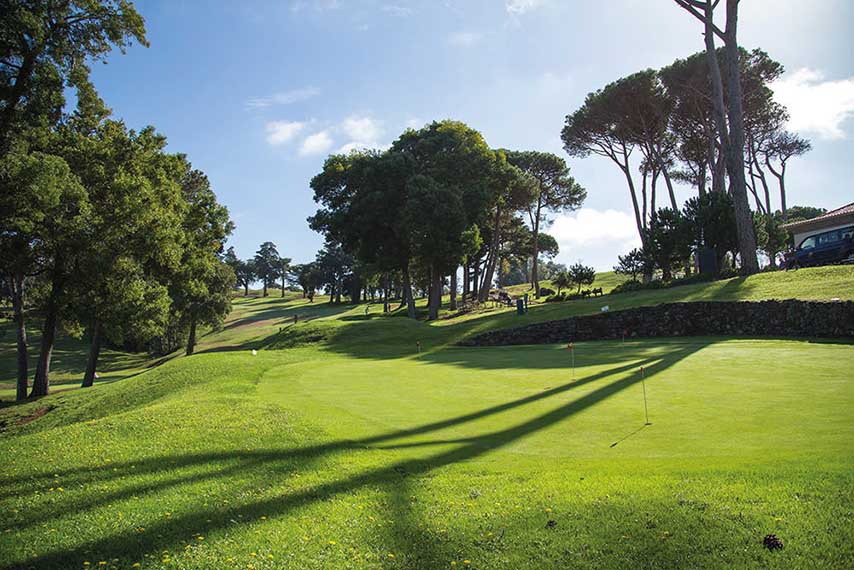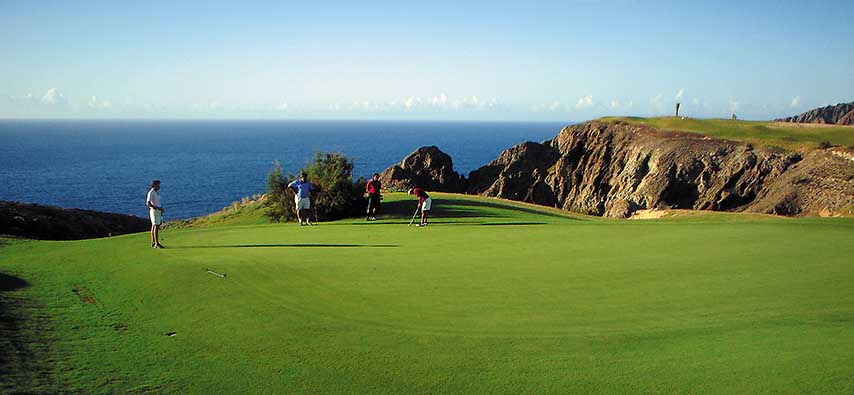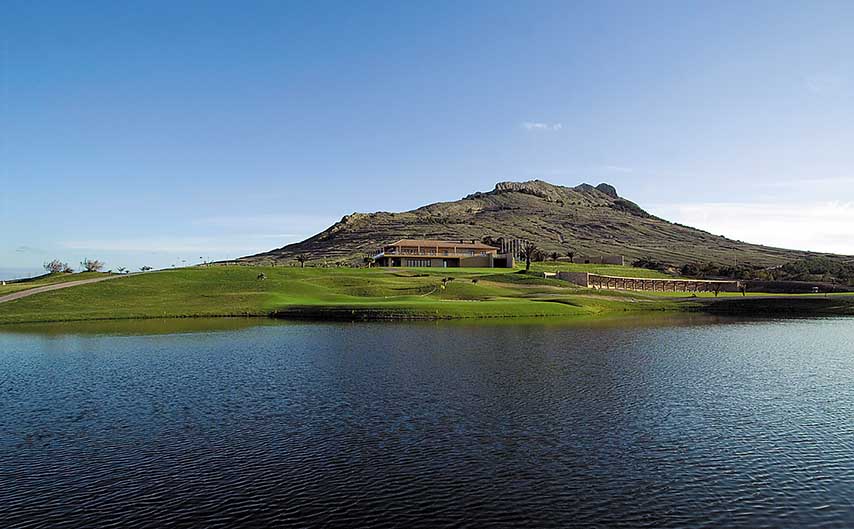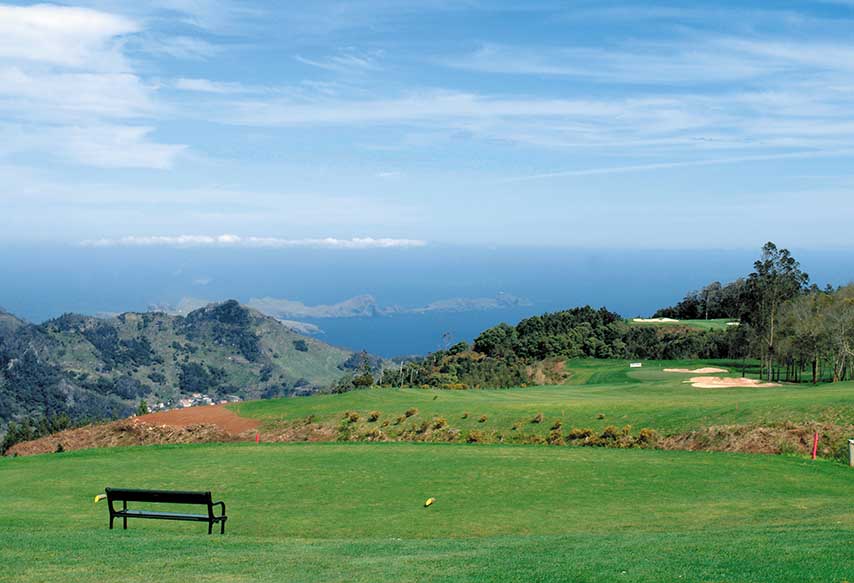Located 500 kilometres from the Moroccan coast and 1,000 from the European continent, in the Atlantic Ocean – 90 minutes from Lisbon – the Madeira archipelago is an exceptional Portuguese enclave offering many attractions to tourists, including top-quality golf. The archipelago comprises the inhabited islands of Madeira and Porto Santo, and the uninhabited Islas Salvajes (Wild Islands) and Desiertas (Desert Islands). Named for its huge amount of trees (“madera”), Madeira is the biggest island and home to nearly all the archipelago’s population, about 250,000 people (Porto Sano only has a few thousand), with most living in the capital, Funchal.
Measuring 57 kilometres long and 22 wide and with a moderate climate (average of 23 in summer and 17 in winter), the island has a rugged terrain, with high cliffs hundreds of metres high and peaks that reach 1,800 metres. In fact, Madeira has the second highest island mountain in Europe, only topped by the Teide. These rugged features have necessitated the construction of 15 tunnels to facilitate road connections. The complicated terrain is apparent when arriving in Madeira by air (cruise ships also travel to the island) and landing on the airstrip – the original having been extended, in an impressive engineering feat, on massive pylons that extend the hill an additional half a kilometre. Under this huge “aerial” section, they have taken advantage of the cover and space to build various multi-sports installations between the pylons.

Due to its rugged topography, Madeira doesn’t have any natural beaches (the artificial ones have been created with sand brought from Morocco), but there are various large public pools around the coastline. There is, however, a magnificent nine-kilometre long natural beach, with fine sands, in Porto Santo, also – for that reason – known as the “golden island”. Porto Santo is 40 kilometres from Madeira, and can be reached in 15 minutes by plane or two and half hours by fast ferry.
Madeira has an extensive range of accommodation amenities, with hotels of all categories offering a total of 30,000 beds. There are several five-star establishments, mostly located in Funchal and its surrounding area. There is also a large selection of restaurants offering a great variety of international cuisine. The main local dishes are fish and seafood – with sport fishing another of the island’s main attractions, especially for blue marlin. Madeira is the ideal place for those enjoying scuba-diving and other water sports.
True to its name
Discovered in 1418 by Portuguese seafarers, Madeira is true to its name: huge areas of trees extend throughout the island. It is not surprising, therefore, that walking is one of the main tourist attractions. Situated in the midst of forests, with trees hundreds of years old, there are tracks and paths that extend for 1,400 kilometres of levies (ditches or channels), enabling visitors to fully appreciate the island’s beautiful and stunning scenery.
Apart from huge forest areas, predominated by tall pine trees, Madeira is also known for the stunning colours of its well-maintained gardens, which include native species alongside others from the more remote corners of the world.
In recent years golf has become a major attraction for tourists visiting the island, mostly mainland Portuguese, Britons, Germans and Nordics. The archipelago has three golf courses, all open to the public: two in Madeira and one in Porto Santo. A fourth course is planned, in Ponta do Pargo, in the north-eastern part of Madeira, which now seems likely to be completed after its construction was suspended for several years.

.
Santo da Serra Golf Club
The most well-known is Santo da Serra Golf Club, a 27-hole layout considered one of the most spectacular courses in Europe, with stunning views over the sea and mountains.
The course was the permanent venue for the Madeira Island Open, on the European Tour, an event held from 1993 until 2015 and won on three occasions by Spaniards (Santiago Luna, Pedro Linhart, and Málaga’s Diego Borrego).
Designed by Robert Trent Jones and inaugurated in 1991, the course is located just a short distance from Funchal, in the Santo da Serra municipality, 15 minutes from the airport. The main layout, a 6,039-metre par-72, features wide fairways, well-manicured greens and a large variety of trees. The views over the coast and sea from this course are spectacularly beautiful.
Next to the course is Estalagem (“charming hotel”) Serra Golf, whose installations include a small palace dating to the early 20th century and which previously was used as a golf clubhouse as well as a “casa de chá” (tea-room).Twenty years ago it was converted into a hotel, and connected to the original house by a large gallery, a more modern wing, where most of the rooms are located. Guests can enjoy a pleasant and relaxing ambience – enhanced by the beautiful natural setting and pleasant service by the staff. Located in the old house – with its pale blue façade – is an attractive lounge room with fireplace and Chester-style sofas, as well as a charming hotel dining room.

.
Palheiro Golf
Palheiro Golf is the second course on the island of Madeira. Designed by American Cabell Robinson and inaugurated in 1993, it is located 500 metres above the Funchal bay, next to the exotic Quinta do Palheiro gardens. The 18-hole, par-72 layout, 6,015 metres long, is undulating and runs between hills and valleys, some quite deep. Next to the course is the charming Casa Velha do Palheiro hotel, a five-star establishment (a member of the “charming hotels” association Relais & Chateaux) which, two centuries ago, was the country estate of the Count of Carvalhal. The property was bought in 1895 by an English family whose descendants, 11 years ago after a major renovation of the original house, opened it as a top-class hotel – with elegant amenities in a cosy British style.

.
Golf de Porto Santo
The third, and youngest, course on the archipelago is Santo Porto Golf, located on the island of the same name. Inaugurated in 2004, it comprises an 18-hole par-72 layout and nine short holes. Another celebrated figure in the world of golf is behind the design: Severiano Ballesteros. The layout has several lakes that come into play, and spectacular holes running alongside the cliffs – while the views are stunning from every point.





